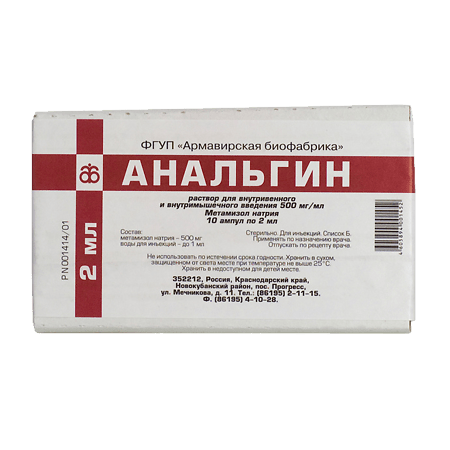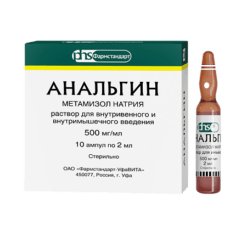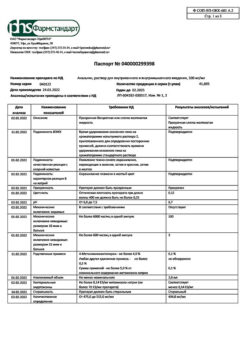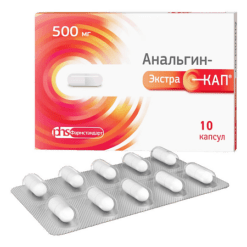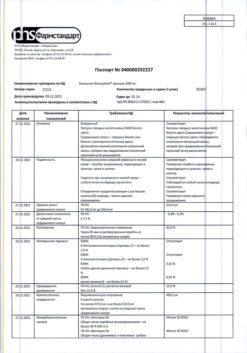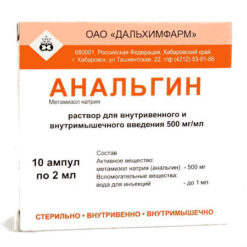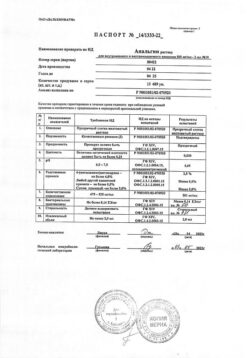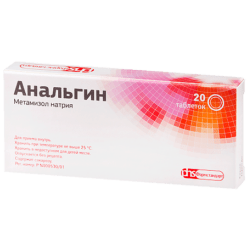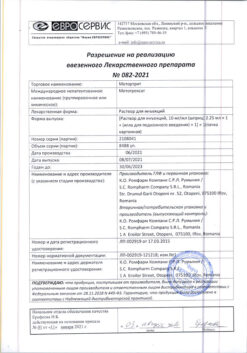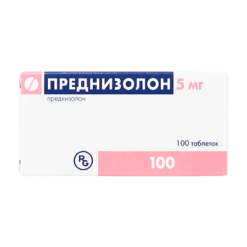No products in the cart.
Analgin, 500 mg/ml 2 ml 10 pcs
€4.81 €4.28
Description
Panalgin non-selectively blocks cyclooxygenase and reduces formation of prostaglandins from arachidonic acid, interferes with conduction of pain extra- and proprioceptive impulses.
The analgin has a weak anti-inflammatory effect, resulting in little effect on the water-salt metabolism (sodium and water retention) and the mucous membrane of the gastrointestinal tract. It has antispasmodic effect on smooth muscles of urinary and biliary tracts. Action develops 20-40 minutes after oral administration.
Pharmacokinetics
After intravenous administration, the elimination half-life for sodium metamizole is 14 minutes.
Approximately 96% is excreted in the urine as metabolites. Binding of the active metabolite with blood plasma proteins is 50-60%. Primarily excreted by the kidneys.
Indications
Indications
Pain syndrome (mild to moderate severity): incl. headache, migraine, toothache, neuralgia, myalgia, radicular syndrome, algodismenorrhea; for renal, hepatic and biliary colic (in combination with antispasmodics).
Analgin can be used to reduce pain after surgical and diagnostic interventions.
Increased body temperature during colds and other infectious and inflammatory diseases. The advisability of using the drug is decided in each case depending on the severity, nature and tolerance of the fever.
Pharmacological effect
Pharmacological effect
Analgin non-selectively blocks cyclooxygenase and reduces the formation of prostaglandins from arachidonic acid, and prevents the conduction of painful extra- and proprioceptive impulses.
Analgin has a weak anti-inflammatory effect, causing little effect on water-salt metabolism (sodium and water retention) and the gastrointestinal mucosa. It has an antispasmodic effect on the smooth muscles of the urinary and biliary tract. The action develops 20-40 minutes after ingestion.
Pharmacokinetics
After intravenous administration, the half-life of metamizole sodium is 14 minutes.
Approximately 96% is excreted in the urine as metabolites. The connection of the active metabolite with blood plasma proteins is 50-60%. Mainly excreted by the kidneys.
Special instructions
Special instructions
In patients suffering from bronchial asthma and hay fever, hypersensitivity reactions may develop.
With long-term use (more than 7 days), it is necessary to monitor the peripheral blood picture. While taking metamizole sodium, agranulocytosis may develop, and therefore, if an unmotivated rise in temperature, chills, sore throat, difficulty swallowing, stomatitis, erosive and ulcerative lesions of the oral cavity, vaginitis or proctitis is detected, immediate discontinuation of the drug is necessary.
Do not use to relieve acute abdominal pain (until the causes are clarified).
To reduce the risk of developing adverse events from the gastrointestinal tract, the minimum effective dose should be used for the shortest possible course.
When treating patients receiving cytotoxic drugs, metamizole sodium should only be taken under medical supervision.
For intramuscular administration, it is necessary to use a long needle.
Active ingredient
Active ingredient
Metamizole sodium
Composition
Composition
1 ml of injection solution contains:
active ingredient:
metamizole sodium (analgin) 500 mg,
excipients:
water for injections up to 1 ml.
Contraindications
Contraindications
hypersensitivity to pyrazolone derivatives (propyphenazone, phenazone or phenylbutazone);
bronchial asthma induced by taking acetylsalicylic acid, salicylates or other non-steroidal anti-inflammatory drugs (NSAIDs);
bronchial obstruction, rhinitis, urticaria, provoked by taking acetylsalicylic acid or other NSAIDs (including a history), condition after CABG;
inhibition of hematopoiesis (agranulocytosis, cytostatic or infectious neutropenia);
severe liver or kidney dysfunction;
hepatic porphyria;
confirmed hyperkalemia, erosive and ulcerative changes in the mucous membrane of the stomach and duodenum, active gastrointestinal bleeding, inflammatory bowel diseases, anemia, leukopenia;
hereditary hemolytic anemia associated with deficiency of glucose-6-phosphate dehydrogenase;
pregnancy (especially in the first trimester and the last 6 weeks), lactation period;
infancy (up to 3 months with body weight less than 5 kg).
Side Effects
Side Effects
From the urinary system: impaired renal function, oliguria, anuria, proteinuria, very rarely the development of acute interstitial nephritis, red coloring of urine (due to the release of a metabolite – rubazonic acid).
Allergic reactions: urticaria, including on the conjunctiva and mucous membranes of the nasopharynx, Quincke’s edema; in rare cases – malignant exudative erythema (Stevens-Johnson syndrome), anaphylactic shock, toxic epidermal necrolysis (Lyell’s syndrome), bronchospastic syndrome (not only with a tendency to bronchospasm).
From the hematopoietic organs: leukopenia, rarely agranulocytosis and thrombocytopenia of immune origin.
Other: possible decrease in blood pressure, heart rhythm disturbance.
Local reactions: with intramuscular administration, infiltrates are possible at the injection site.
Interaction
Interaction
The simultaneous use of Analgin with other non-narcotic analgesics can lead to mutual enhancement of toxic effects.
Tricyclic antidepressants, oral contraceptives and allopurinol interfere with the metabolism of metamizole sodium in the liver and increase its toxicity.
Barbiturates and phenylbutazone weaken the effect of Analgin.
Analgin enhances the effects of alcohol-containing drinks.
Radiocontrast drugs, colloidal blood substitutes and penicillin should not be used during treatment with metamizole sodium.
Metamizole sodium, displacing oral hypoglycemic drugs, indirect anticoagulants, glucocorticosteroids and indomethacin from protein binding, increases their activity.
The simultaneous use of Analgin with cyclosporine reduces the level of the latter in the blood.
Thiamazole and sarcolysin increase the risk of developing leukopenia.
The effect is enhanced by codeine, H2-histamine receptor blockers, and propranolol (slows down inactivation).
Sedatives and tranquilizers enhance the analgesic effect of Analgin.
Myelotoxic drugs increase the manifestations of hematotoxicity of the drug.
Due to the high probability of pharmaceutical incompatibility, metamizole should not be mixed with other drugs in the same syringe.
Overdose
Overdose
In case of overdose, consult a doctor. The following symptoms may occur: nausea, vomiting, stomach pain, oliguria, hypothermia, decreased blood pressure, tachycardia, shortness of breath, tinnitus, drowsiness, delirium, disturbances of consciousness, acute agranulocytosis, hemorrhagic syndrome, acute renal and/or liver failure, convulsions, paralysis of the respiratory muscles.
Treatment: symptomatic. There is no specific antidote for metamizole sodium. In a medical institution – forced diuresis, hemodialysis, with the development of convulsive syndrome – intravenous administration of diazepam and fast-acting barbiturates.
Storage conditions
Storage conditions
In a place protected from light, out of reach of children, at a temperature not exceeding 25°C
Manufacturer
Manufacturer
Armavir biofactory FKP, Russia
Additional information
| Conditions of storage | In the dark place, out of the reach of children, at a temperature not exceeding 25°C |
|---|---|
| Manufacturer | Armavirskaya Biofabrika FKP, Russia |
| Medication form | solution |
| Brand | Armavirskaya Biofabrika FKP |
Other forms…
Related products
Buy Analgin, 500 mg/ml 2 ml 10 pcs with delivery to USA, UK, Europe and over 120 other countries.

